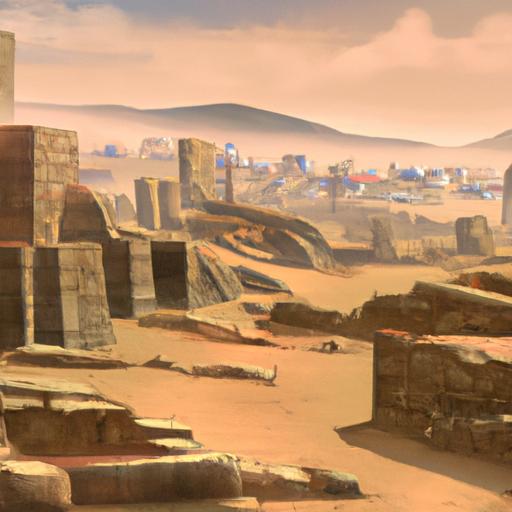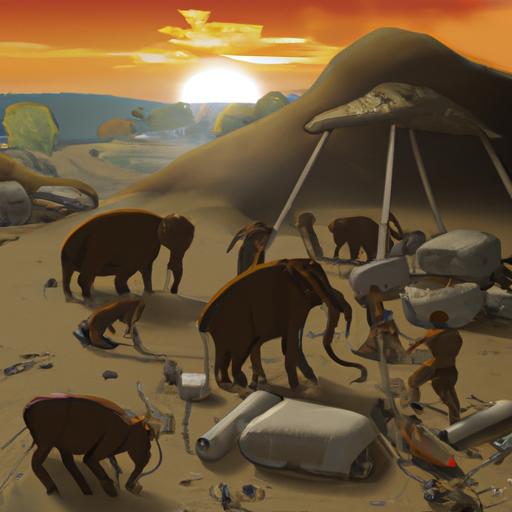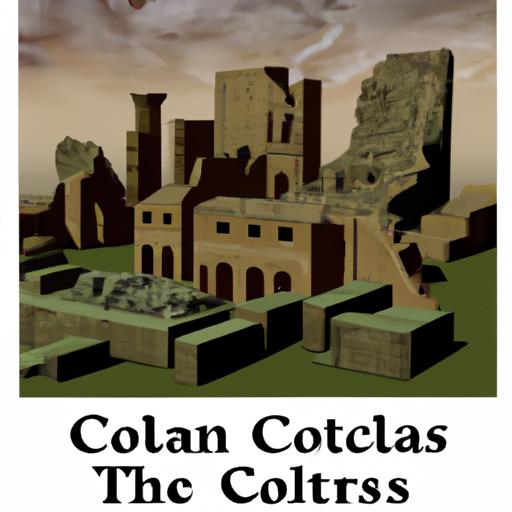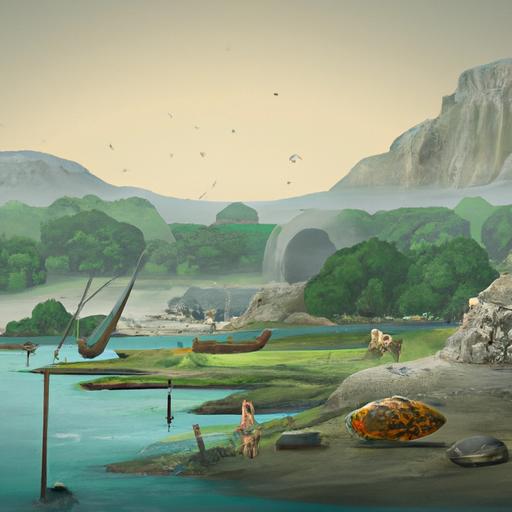This article may contain factual errors. It was created by the openai-ghostwriter 1.0.1. This is a python script for automatic generation of web pages powered by the OpenAI's GPT-3.
Dieser Artikel kann Unsinn und falsche Aussagen enthalten! Er wurde vom openai-ghostwriter 1.0.1 erzeugt. Das ist ein Python-Skript für die vollautomatische Erstellung von Webseiten.
The Late Bronze Age Collapse

The Late Bronze Age Collapse (LBAC) was a period of dramatic upheaval and destruction that occurred in the Eastern Mediterranean region around 1200 BC. It marked the end of the Bronze Age and ushered in a new era of Iron Age civilizations. The LBAC is one of the most significant events in human history, as it caused widespread political, economic, and social disruption across the entire region.
The causes of the LBAC remain largely unknown, though various theories have been proposed. One popular theory suggests that a series of natural disasters such as earthquakes, drought, and famine caused by climate change led to the collapse. Another theory suggests that invasions from outside forces such as the Sea Peoples or Mycenaeans played a role in bringing about the collapse.
Whatever its cause, the LBAC had far-reaching consequences for many civilizations in the region. In Egypt, for example, it marked the end of an era of great prosperity and power known as the New Kingdom. In Canaan (modern-day Israel), it resulted in a period of chaos and destruction known as the Dark Ages. In Anatolia (modern-day Turkey), it caused a decline in population and an abandonment of cities.
The effects of the LBAC were felt throughout Europe as well. In Greece, it brought about a period of political instability known as “the Greek Dark Ages” which lasted until around 800 BC. In Italy, it caused a shift from Bronze Age to Iron Age cultures which lasted until around 500 BC.
The LBAC is still studied today by archaeologists and historians alike who are trying to understand its causes and consequences. While much remains unknown about this mysterious event, it is clear that its effects were far-reaching and long-lasting. The Late Bronze Age Collapse was one of the most significant events in human history and continues to shape our understanding of ancient civilizations.
Background Information
 The LBAC had a major impact on the development of later civilizations in the region. It marked the end of an era of international trade networks and large-scale empires, leading to a period of fragmentation and decentralization. In addition, it led to significant changes in art, architecture, religion, and writing systems.
Despite its importance in history, much about the LBAC remains unknown. Archaeological evidence is often incomplete or contradictory, making it difficult to draw any definitive conclusions about its causes or effects. Nevertheless, it remains an important topic for further research.
The LBAC had a major impact on the development of later civilizations in the region. It marked the end of an era of international trade networks and large-scale empires, leading to a period of fragmentation and decentralization. In addition, it led to significant changes in art, architecture, religion, and writing systems.
Despite its importance in history, much about the LBAC remains unknown. Archaeological evidence is often incomplete or contradictory, making it difficult to draw any definitive conclusions about its causes or effects. Nevertheless, it remains an important topic for further research.
Historical Context
The LBA began with the collapse of the Hittite Empire in Anatolia around 1200 BC. This event was followed by the destruction of many other Bronze Age civilizations, including those in Syria, Palestine, Egypt, Greece, and Crete. The causes for this collapse are still debated among scholars but most agree that it was due to a combination of factors. These include invasions from outside forces such as the Sea Peoples, internal strife between rival states, and environmental changes such as drought or earthquakes. The effects of the LBA were far-reaching and long-lasting. In some areas, entire cities were destroyed while others were abandoned or left in ruins. Trade networks were disrupted and economies collapsed as people sought refuge elsewhere. Political power shifted away from centralized empires towards smaller city-states or tribal groups. Culturally, there was a shift away from large-scale monumental architecture towards smaller scale buildings with simpler designs. The aftermath of the LBA saw a period of political fragmentation across much of the Mediterranean region. This led to a decline in international trade as well as an increase in local conflicts between rival states or tribes. In some areas, such as Greece and Anatolia, this fragmentation gave rise to new forms of government such as democracy or oligarchy. In other areas, such as Syria and Palestine, this period saw an increase in religious diversity and syncretism. The Late Bronze Age Collapse had a profound effect on world history. It marked the end of an era when powerful empires dominated much of the Mediterranean region and ushered in a period characterized by political fragmentation and cultural change. Although its causes are still debated among scholars today, it is clear that this event had far-reaching consequences for many societies throughout the ancient world.Geographical Setting
Geographically, the Late Bronze Age collapse affected much of what is now known as the Middle East, including modern-day Turkey, Syria, Iraq, Iran, Israel/Palestine, Egypt, Lebanon, Jordan and Cyprus. It also had an impact on parts of Europe such as Greece and Italy. The effects were felt most strongly in Anatolia (modern-day Turkey), which was home to several powerful civilizations at this time. These included the Hittite Empire, which had been one of the most powerful states in the region for centuries. The causes of the Late Bronze Age collapse are still debated among scholars today. Some believe that it was caused by external forces such as invasions from foreign powers or natural disasters like earthquakes or drought. Others argue that internal factors such as political instability or economic decline played a role. Still others suggest that it was a combination of both external and internal factors that led to its downfall. One possible cause for the collapse is thought to be an invasion by groups known as Sea Peoples. These groups are believed to have originated from areas around the Aegean Sea and may have included Mycenaeans from Greece and Philistines from Canaan (modern-day Israel/Palestine). They are thought to have attacked cities along coastal regions throughout Anatolia and other parts of the Middle East during this time period. Another possible cause for the collapse is thought to be environmental changes due to climate change or natural disasters such as earthquakes or drought. These environmental changes could have caused crop failures leading to famine and social unrest which may have contributed to political instability in some areas. Additionally, some scholars believe that overpopulation may have played a role in weakening societies during this time period. The Late Bronze Age collapse had far-reaching consequences for many ancient civilizations in this region. It marked a major shift in power dynamics between different states and empires in this area, with some being weakened while others grew stronger. It also led to migrations of people from one area to another as they sought refuge from war or famine. Finally, it ushered in a new era for many cultures with new technologies being developed during this time. The Late Bronze Age collapse has been studied extensively by scholars over many years but its exact causes remain unknown. However, what is clear is that it had a significant impact on many ancient civilizations throughout this region and changed their course forever.Causes of Collapse
 The effects of this collapse were far-reaching. Major cities were destroyed or abandoned, trade networks collapsed, and many civilizations disappeared entirely. In addition to this physical destruction, there was also a cultural shift away from urban life and towards more rural lifestyles. This period marks a major transition in human history and has been studied extensively by historians.
The Late Bronze Age Collapse is an important event in world history that has shaped our understanding of ancient civilizations. Its causes are still debated today, but it is clear that it had a profound impact on the societies of the time.
The effects of this collapse were far-reaching. Major cities were destroyed or abandoned, trade networks collapsed, and many civilizations disappeared entirely. In addition to this physical destruction, there was also a cultural shift away from urban life and towards more rural lifestyles. This period marks a major transition in human history and has been studied extensively by historians.
The Late Bronze Age Collapse is an important event in world history that has shaped our understanding of ancient civilizations. Its causes are still debated today, but it is clear that it had a profound impact on the societies of the time.
Environmental Factors
The first environmental factor that likely contributed to the collapse was drought. In 1200 BCE, a severe drought began in the Eastern Mediterranean region that lasted for over two centuries. This drought caused a decrease in crop yields and led to famine in many areas. The lack of food caused by this drought likely weakened many populations, making them more vulnerable to other factors such as disease and warfare. In addition to drought, famine was another major factor that likely contributed to the collapse. Famine is often caused by prolonged periods of drought; however, it can also be caused by other factors such as war or political instability. During this period, there was much political unrest in the region due to invasions from outside forces and internal conflicts between different factions within empires. This unrest likely disrupted trade routes and caused food shortages in many areas. Finally, disease may have also been a factor in the collapse. During this time period, diseases such as smallpox were common throughout the region. These diseases could spread quickly through populations that were weakened by famine or other environmental factors. It is possible that these diseases could have killed large numbers of people and weakened populations even further. In conclusion, environmental factors such as drought, famine, and disease likely played a major role in causing the Late Bronze Age Collapse. Drought led to decreased crop yields and famine; famine made populations more vulnerable to disease; and disease could have killed large numbers of people. All of these factors combined likely contributed to the downfall of many powerful empires during this time period.Political Factors
One of the most significant political factors that led to the collapse was the rise of new powers in the region. During this period, many smaller city-states began to emerge in various parts of the Mediterranean region. These city-states often competed for resources and power with their larger neighbors, leading to increased tension and conflict. This competition also weakened existing political structures, as rulers had to focus more on defending their own territories than on maintaining a unified empire. Another important political factor was the decline of long-distance trade networks. During this period, many empires relied heavily on trade networks that connected them with distant regions. However, these networks began to break down due to increased competition between city-states and other powers in the region. This decline in trade meant that empires could no longer access resources from distant lands, leading to economic instability. Finally, internal political divisions also played a role in causing the collapse. Many empires during this period were ruled by dynasties that had been in power for centuries. Over time, these dynasties became increasingly divided over how best to govern their realms. This internal strife weakened existing political structures and made it difficult for rulers to effectively manage their empires. In conclusion, there were several political factors that contributed to the Late Bronze Age Collapse. The rise of new powers in the region led to increased competition between states and weakened existing political structures. The decline of long-distance trade networks also caused economic instability within empires. Finally, internal divisions among ruling dynasties further weakened existing power structures and made it difficult for rulers to effectively manage their realms.Consequences of Collapse
 The consequences of this collapse were far-reaching. It resulted in political instability and warfare throughout the region, as well as famine and disease. It also caused a disruption in trade networks which had previously connected these civilizations. This led to a decrease in cultural exchange and technological advancement, which had been an important part of life during the Late Bronze Age.
The Late Bronze Age collapse was one of the most significant events in human history. Its consequences are still felt today, as many of its effects are still visible in modern societies.
The consequences of this collapse were far-reaching. It resulted in political instability and warfare throughout the region, as well as famine and disease. It also caused a disruption in trade networks which had previously connected these civilizations. This led to a decrease in cultural exchange and technological advancement, which had been an important part of life during the Late Bronze Age.
The Late Bronze Age collapse was one of the most significant events in human history. Its consequences are still felt today, as many of its effects are still visible in modern societies.
